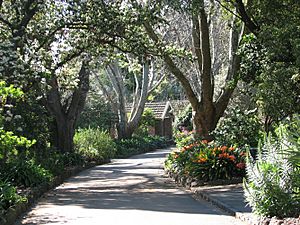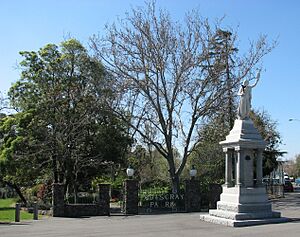Footscray Park facts for kids
Footscray Park is a really big and beautiful park in Footscray, Victoria, Australia. It sits right on the south bank of the Maribyrnong River. This park is about 15 hectares, which is like 15 football fields! It's special because it's one of the best examples of an Edwardian park left in Australia. Edwardian means it was designed around the early 1900s. The park is famous for its amazing collection of plants, pretty ponds, and cool garden buildings. It's even listed on the Victorian Heritage Register because it's so important for its beauty, plants, and history. In fact, it was the first garden ever added to this special list!
Contents
Park History: How it Began
Footscray Park was created because local people really wanted a park in the area. They worked hard to convince others to make it happen. In 1911, a design competition was held, and an architect named Rodney Alsop won. He created the original plan for the park.
A group called the Footscray Park Beautification Committee was formed. This committee was made up of local residents, businesses, and individuals who all wanted to help. A lot of the work to build the park was done by volunteers, including local Boy Scouts! By 1914, the park already had many Australian native plants, especially Eucalyptus and Acacia trees.
Many of the park's cool features, like archways, bridges, and ponds, were built by people who didn't have jobs during a tough time called the Depression. Most of the park's design and building was overseen by David Mathews. He was the Superintendent of Parks and Gardens for the City of Footscray for a very long time, from 1916 to 1964! An orchid expert named William Nicholls also helped with the planting.
The park has also been a part of history! In 1928, 40,000 people gathered on the park's slopes. They wanted to see Bert Hinkler land his plane at Flemington Racecourse. He had just completed the first solo flight from England to Australia. The park has also hosted big events, like the Saltwater Festival and the Vietnamese Festival.
Exploring the Park's Features
When you enter Footscray Park from Ballarat Road, you'll see cool stone walls. They have wrought iron gates that spell out "Footscray Park." Right at the entrance, there's a World War I memorial. It was revealed in 1922. This memorial has a beautiful marble statue of Victory on a granite base. It was sculpted in Italy.
If you walk further, you'll find a rustic stone lookout shelter and pergola. Students from Footscray Technical School designed and built this in 1928. From here, you get an amazing view of the Maribyrnong River and Flemington Racecourse. Close by, there's a bust (a statue of someone's head and shoulders) of Henry Lawson. He was a famous Australian poet and writer. This honors him and an event held in the park by the Henry Lawson Literary Society.
The park has two main paths that run east to west along the hill. There used to be three! These paths are crossed by another path that goes north to south. This is called the T.B. Drew Memorial Walk. It goes down the hill through an archway covered in beautiful wisteria flowers, leading to the Thomson Water Garden.
You might also spot the Alfred Green Memorial Fountain. Locals sometimes call it the "platypus fountain." It's a unique granite fountain with two sculpted platypus at its base! The park also has open fields near the river, perfect for playing games.
Amazing Trees in the Park
Footscray Park has a wonderful collection of old and diverse trees. You can find palms, elms, ash, oaks, and cypress trees. There are also many different Australian native species. Some of the trees in the park are quite rare to find growing in Australia!
Here are some of the special trees mentioned in its heritage listing:
- Brahea armata (Blue Hesper Palm)
- Clerodendrum glabrum (There are two of these trees!)
- Cupressus macrocarpa 'Hodginsii'
- Ficus microcarpa var. hillii (Hill's Fig)
- Melaleuca halmaturorum
- Quercus aff. stellata
- Vitex agnus-castus
- Ulmus glabra 'Exoniensis' (Exeter Elm)
Images for kids





